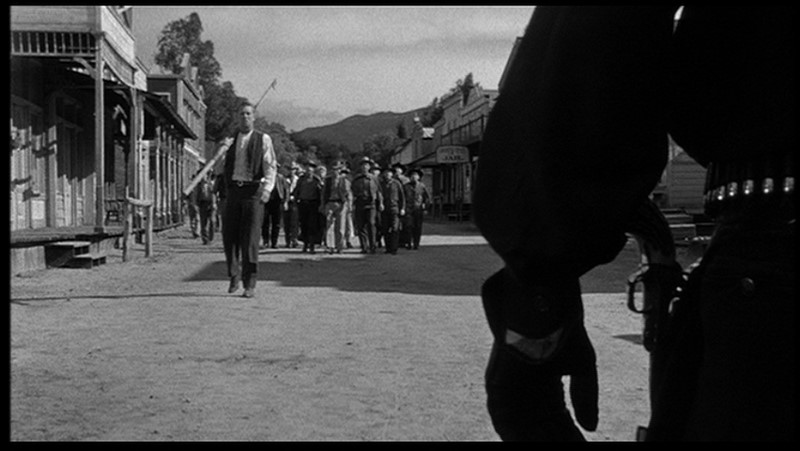Joseph H. Lewis’ reputation was built on his ability to create surprisingly artful films out of extremely base material, transforming ultra-low budgets and relatively unknown casts into movies that, if they weren’t cinematic classics, were at least far better than they had any right to be. Responsible for two of the least-known and best-made post-war noir thrillers — Gun Crazy and The Big Combo — he never made anything that wasn’t B-movie filler, but his ambition and talent led him to stretch his films in the direction of A-movie ambition. Terror in a Texas Town, for all its small virtues, isn’t anywhere near on the level of those two films; it’s mostly notable for its gimmicky final showdown, its lead performance from Sterling Hayden, and its status as the last movie made by Lewis before he retired from the big screen and worked in television for the rest of his career. But it’s worth a viewing, even if it doesn’t rank with his finest films, because it displays that same quality of ambition on the cheap that marks those movies.
Terror in a Texas Town, released in 1958, is essentially a cheap knockoff of High Noon. While it doesn’t play up the anti-Communist angle as much as its source, that angle can’t bee completely ignored, especially with the knowledge that the canny screenplay was written by the blacklisted Dalton Trumbo under a front. It’s a typical one-man-stands-alone riff, though, updating its story slightly to the era when Texas’ oil wealth began to overtake the cattle industry as a primary source of income. An oily, needling Sebastian Cabot plays the big bad guy, a local land baron who’s become aware that a stretch of relatively worthless land nearby sits atop a vast reservoir of oil, and uses a squad of goons — led by the sneering, brutal Ned Young — to terrify the landowners away before they discover how much their farms are truly worth. One man who isn’t scared off is the towering, grim-faced whaler Sterling Hayden; he arrives to help his father with his small farm, only to learn the old man has been killed. His stony determination to find out what happened runs into resistance from the bought-off local law and fear from the Latino locals, who are too cowed to admit to him why Cabot wants the land so badly. Eventually, he rallies them to stand behind him in a final confrontation with Young.
Hayden, who’s one of my all-time favorite actors, can usually be counted on to be the best thing about any movie he’s in, but while he’s got his moments here — usually right when he’s about to do something violent — the rest of his scenes are hobbled by the decision to speak in an absurd yumpin’-yiminy Swedish accent. Whether this was a choice or a direction, it sinks some of his best moments and keeps him from anchoring the movie the he normally would. However, there are some supporting roles that help buoy Terror above the typical B-movie range. Cabot rarely gets past his sinister fat man part, but some of the early scenes, where he deliberately needles his murderous henchman just to prove who’s in charge, have a dangerous and slimy air that elevates them to an enjoyable level. Young has a more interesting part as the vicious gunman, and refrains from hamming it up even in his most evil moments (as when he guns down a father in front of his young son); he’s hatefully unsatisfied with where life has put him, running bloody errands for someone as unworthy as Cabot, and seeks someone worth his murderous rage. Eugene Mazzolla brings dignity and an odd realism to his role as the well-meaning, doomed Mexican-American farmer, and Carol Kelly and Marilee Earle do what they can with vaguely drawn molls.
The plot of Terror in a Texas Town moves along at a pretty leisurely pace, doling out its moments of excellence far too slowly. And while Lewis finds ways here, as he does in his other films, of setting up interesting shots and clever visual compositions out of the deep restrictions of his budget, the cheapness of the film really shows through, and keeps it from attaining the cinematic excellence of a movie like The Big Combo. It’s too lacking to be considered anything but a second-rate western with highly individualistic qualities. But it’s those qualities that make the movie: the surprise turn at the end concerning the fate of Cabot, the clever score, the bizarre harpoon-vs.-sixgun showdown that bookends the movie (which led to its unforgettable tagline “IRON-HOOKED FURY!”), the shading Young brought to his bad-guy role informed by weird little details like his literal iron hand, and those few points where Lewis is able to find a little work-around here and there and make it look like a much bigger and better film. That was his genius: even his lesser movies seemed a lot better than they really were, and when he really scored, they achieved a quiet kind of greatness.


Pingback: The Most Beautiful Fraud: Terror In A Texas Town « Screengrab In Exile